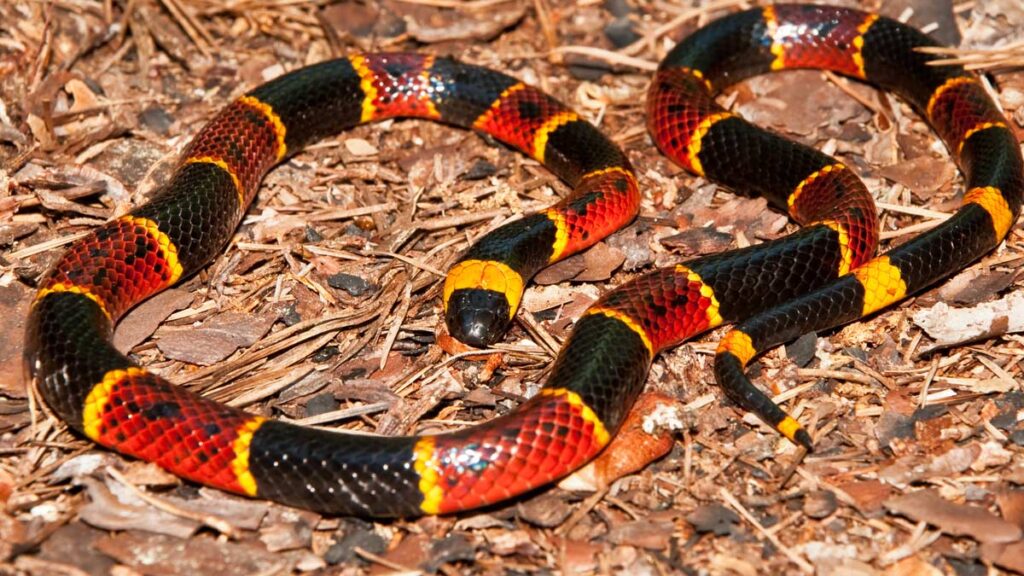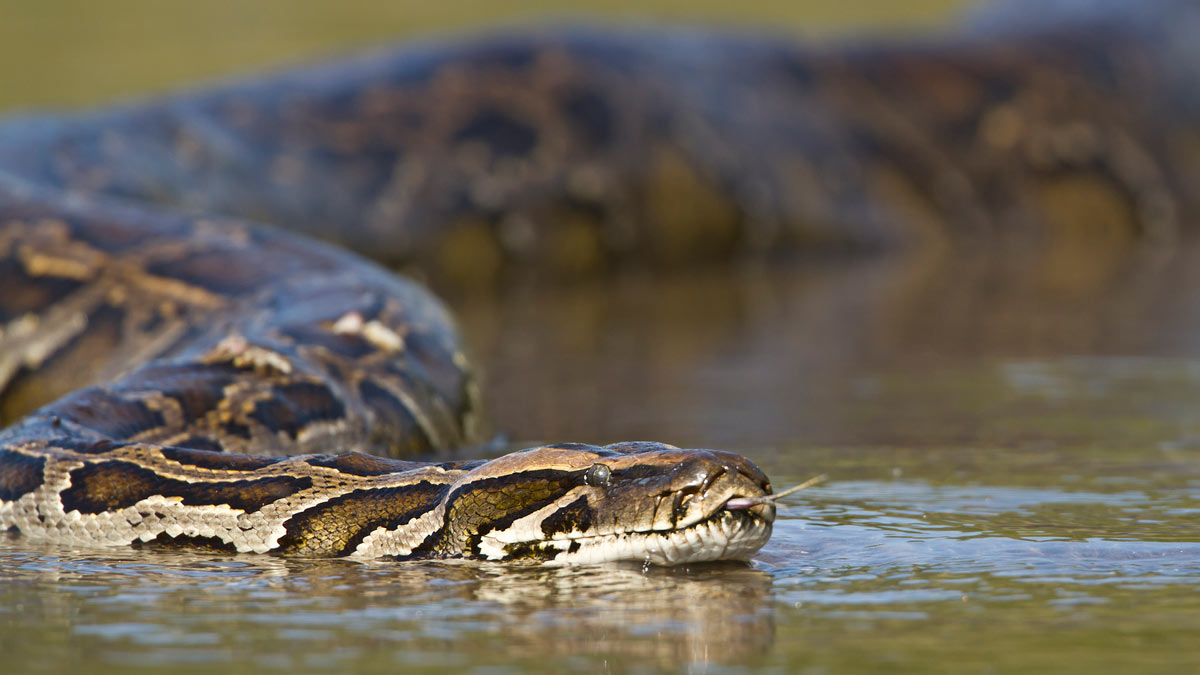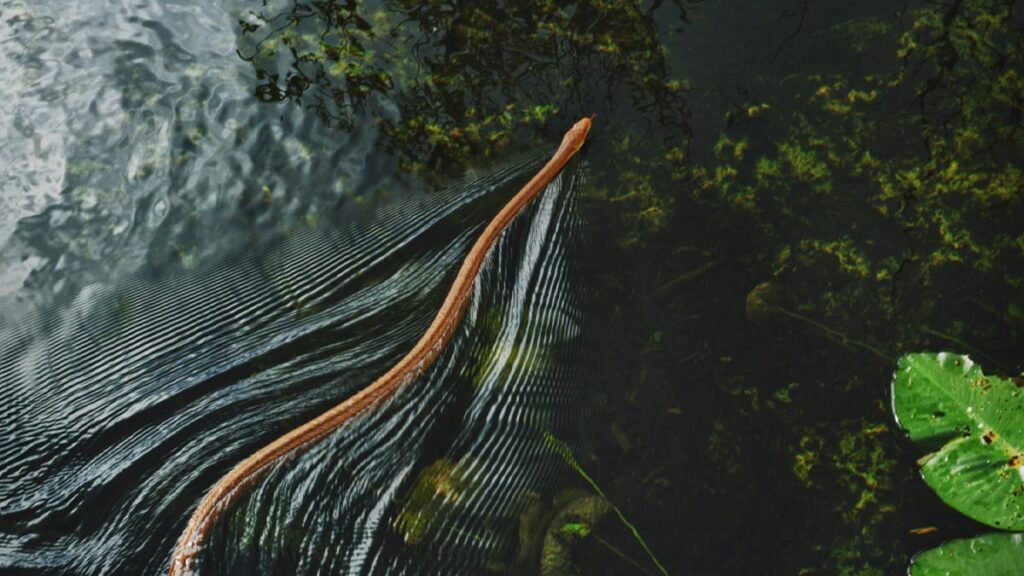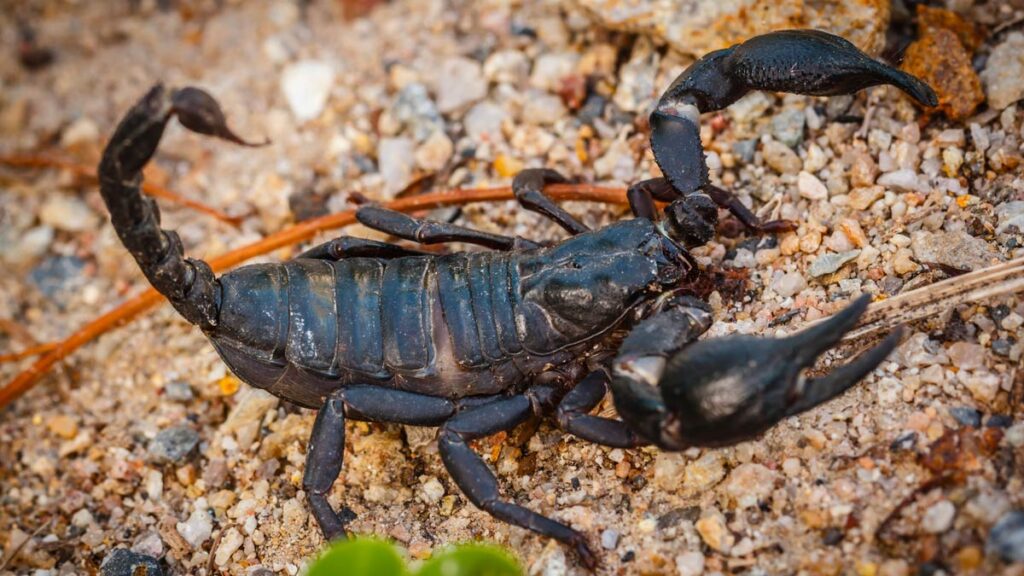
Burmese Pythons and Their Devastating Impact on Florida's Ecosystem
The Silent Stranglehold
Updated on: January 2024

Invasive species are organisms that have been introduced, either intentionally or accidentally, to an environment outside their natural habitat and often wreak havoc by outcompeting, preying on, or bringing diseases to native species. Their impact can be so profound that they disrupt ecological processes, affect human health, and result in significant economic consequences. Florida, with its rich biodiversity, has unfortunately not been spared from this ecological challenge. The Burmese python, a formidable reptile native to Southeast Asia, has become one of the Sunshine State’s most pressing environmental threats. Initially brought to the U.S. for the exotic pet trade, many of these snakes were released or escaped into Florida’s wild, where they found an environment conducive to rapid proliferation. With no natural predators to keep their numbers in check, the python’s population exploded, threatening the delicate balance of Florida’s unique ecosystem.
Find What You Need
Origin of the Python Problem
The story of the Burmese python in Florida is a complex one, woven together by a series of unforeseen events and human choices. The initial introduction of this snake to the United States can be traced back to the 1970s and 1980s when they became popular in the exotic pet trade. Enthusiasts, taken by the python’s unique appearance and size, imported them in significant numbers. Over time, as these snakes grew from manageable hatchlings to massive adults, often exceeding 12 feet in length, many owners found themselves overwhelmed by the care requirements and costs. As a result, some owners chose to release them into the wild, mistakenly believing they were doing the right thing for the animal.
Furthermore, in the late 1990s, Hurricane Andrew devastated parts of South Florida, and it’s believed that some breeding facilities were destroyed, leading to the unintentional release of a significant number of pythons into the Everglades. The warm, swampy environment of the Everglades proved to be an ideal habitat for the pythons, and they began to flourish. Their rapid reproduction, coupled with a lack of natural predators in the region, allowed their numbers to swell unchecked.
Estimating the exact population of Burmese pythons in Florida is a challenging endeavor due to their elusive nature and vast habitats like the Everglades. However, based on expert assessments and captures, the current population is believed to be in the tens of thousands. Some more pessimistic estimates even suggest there could be upwards of 100,000 pythons lurking in the state’s waterways, forests, and swamps. This burgeoning population has had cascading effects on Florida’s ecology, signaling the urgency for effective intervention measures.
Ecosystem Disruption
Florida’s rich and unique ecosystem has suffered palpable disruptions due to the python invasion, affecting everything from mammals and birds to the very structure of the food web.
Florida’s Unique Ecosystem and Vulnerabilities
Florida’s ecosystem is a mosaic of biomes, from the dense mangroves to the sprawling Everglades. Central to this landscape is the Everglades, a biodiverse wetland that offers refuge to countless species, many endemic to the region. However, while this environment thrives in its natural state, it is highly susceptible to external disruptions, especially from invasive species that can rapidly alter habitat dynamics.
Impact on Native Mammal Populations
The marsh rabbit, once a common sight in the Everglades, has faced a precipitous decline. Certain areas have recorded drops of over 90% in their numbers. This trend isn’t limited to rabbits. Iconic creatures like raccoons, possums, and bobcats are now far less frequently observed where pythons have established dominance.
Effects on Local Bird Populations
Ground-nesting birds are at an increased risk due to the python menace. Species like the endangered Cape Sable seaside sparrow are finding their nests raided more frequently, leading to reduced offspring survival rates. Other species under threat include the wood stork, roseate spoonbill, and the white ibis, all of which have shown declining numbers in areas with python presence.
Key Takeaway
The invasive Burmese python has dramatically reshaped Florida’s ecosystem, with the Python Challenge™ alone resulting in the removal of over 750 pythons in 2020, underscoring the urgent need for collective action to protect global biodiversity.
Alteration of the Local Food Chain
The introduction of the python has upended the traditional food dynamics of the Everglades. Apex predators of the region, such as alligators and Florida panthers, are now competing for drastically reduced prey. In some shocking instances, larger pythons have been observed preying on alligators, adding a new, unnerving dimension to the region’s food web.
Challenges to Native Predators
The python’s voracious appetite and rapid reproduction rate present dual challenges to native predators. Not only are these predators competing for dwindling resources, but they are also contending with a newcomer that can rival, and sometimes surpass, them in predatory prowess. This reshuffling of the ecosystem’s hierarchy further complicates the preservation efforts for the Everglades’ native inhabitants.
Broader Ecological Consequences
Beyond direct predation, the presence of the Burmese python has far-reaching effects, influencing wetland dynamics, fisheries, plant life, and even introducing new health concerns.
Shifts in Wetland Ecosystems Dynamics
The wetlands of Florida, especially the Everglades, are intricate systems with delicately poised dynamics. With the proliferation of the Burmese python, these dynamics have been substantially altered. Wetlands traditionally act as nutrient filters, with each trophic layer playing a specific role. As pythons consume mammals and birds, decomposer populations, which feed on the remains left by native predators, might face food shortages. This can potentially alter nutrient cycling, leading to changes in water quality and the overall health of the wetland system.
Impacts on Florida’s Fisheries and Water Systems
Fisheries, an essential facet of Florida’s economy and ecology, haven’t been immune to the python invasion. With pythons consuming a vast number of wading birds, fewer birds are available to feed on fish. This may lead to overpopulation of certain fish species and underpopulation of others, disrupting the balanced fish community structure. Moreover, changes in wetland water quality, resulting from shifts in ecosystem dynamics, can indirectly affect fish health, breeding patterns, and overall populations.
Indirect Effects on Florida’s Flora Due to Fauna Shifts
The decline in certain mammal populations directly affects the plant communities of Florida. Many plants rely on these mammals for seed dispersal. For instance, the reduction in raccoon or possum populations can affect the distribution and germination rates of plants whose seeds they spread. Similarly, fewer wading birds might lead to altered patterns of plant decay and growth in aquatic habitats, as these birds often play roles in seed transportation and the breakdown of aquatic vegetation.
Potential Introduction or Spread of Diseases and Parasites
Burmese pythons, being non-native, can introduce or serve as reservoirs for diseases and parasites not previously common in Florida’s wildlife. For example, the lung parasite Raillietiella orientalis, commonly found in Burmese pythons, can infect native snakes, potentially leading to respiratory distress or death. Additionally, the sheer density of the python population might accelerate the spread of diseases among the snakes, which could then be transmitted to native species, either directly or through shared prey.
Human and Economic Implications
The invasion of the Burmese python is not only an ecological concern but also poses tangible challenges to local communities, businesses, and Florida’s vibrant tourism industry.
Challenges and Concerns Faced by Local Communities and Businesses
Local communities, particularly those in close proximity to the Everglades and other affected habitats, have reported an increase in sightings of Burmese pythons. For many, the presence of these large predators in their backyards and local areas has become a genuine concern for the safety of pets and, in some cases, small children. Furthermore, businesses that rely on the native wildlife as part of their allure, such as petting zoos, nature resorts, or guided wildlife tours, are struggling to maintain their selling points. The reduced visibility of native species diminishes the overall experience for visitors, leading to decreased interest and attendance.
Economic Repercussions for Florida’s Wildlife Tourism Industry
Florida’s wildlife tourism, a significant contributor to the state’s economy, is under threat due to the python invasion. As native species numbers dwindle, the richness and diversity that once attracted nature enthusiasts to the state have been compromised. Tour operators report decreased sightings of once-common mammals and birds, leading to dissatisfied tourists and negative reviews. This decline in the quality of wildlife encounters has led to reduced bookings, impacting the livelihoods of those reliant on tourism. Moreover, the costs associated with managing and attempting to control the python population, through initiatives like bounty programs, further strain the state’s economic resources.
Changes in the Ecosystem Affecting Future Tourism and Local Lifestyle
The profound shifts in Florida’s ecosystem brought about by the python invasion have long-term implications for both tourism and the way of life for local residents. The potential decline in fish populations could affect recreational fishing, a pastime and tourist attraction in the state. Additionally, altered wetland dynamics might impact activities like kayaking or bird-watching. For locals, a disrupted ecosystem can affect everything from the availability of certain food sources, like fish, to changes in landscape aesthetics due to shifts in flora. There’s also the cultural aspect: for many Floridians, the native wildlife is a point of pride and identity, and its decline could erode the sense of connection they feel to their home state.
Management and Mitigation Efforts
Wildlife Agency Strategies for Python Population Control
The Burmese python problem in Florida has compelled wildlife agencies to adopt aggressive yet calculated strategies. Central to these efforts has been the Florida Fish and Wildlife Conservation Commission (FWC). Recognizing the urgency and scale of the python invasion, the FWC implemented the innovative Python Removal Contractor Program. Under this initiative, trained hunters, referred to as contractors, are enlisted and compensated for their efforts in capturing and humanely euthanizing these invasive reptiles. The program adopts a tiered payment structure, which offers increasing compensation based on the size of the captured python. This approach intentionally targets larger, breeding-capable individuals, aiming to disrupt the python’s reproductive cycle and curb population growth.
Parallel to the FWC’s efforts, the South Florida Water Management District (SFWMD) has been proactive in its approach with the inception of the Python Elimination Program. This program extends beyond just python capture; it provides additional incentives to participants for locating and reporting nests with eggs, a critical step in preventing future generations of pythons from hatching and joining the population.
Both of these programs, while immediately focused on population control, serve a dual purpose. They also facilitate the collection of invaluable data regarding python behaviors, preferred habitats, and breeding patterns. Such information is crucial for refining strategies and ensuring that efforts are targeted and effective in the long run.
Role of Citizen Science Programs and Their Successes
The Florida Fish and Wildlife Conservation Commission (FWC) has expanded its efforts against the Burmese python menace by introducing and heavily promoting the Python Challenge™. More than a simple capture initiative, the Python Challenge™ ingeniously combines public engagement with citizen science. By inviting both seasoned hunters and amateurs to participate, FWC casts a wider net, substantially increasing the chances of locating and capturing these elusive reptiles.
However, the Python Challenge™ serves a purpose beyond just python removal. It operates as a robust educational platform, dedicated to raising awareness about invasive species as a whole. Participants, and even spectators, are exposed to detailed information about the origins, behaviors, and profound ecological threats posed by invasive species, particularly the Burmese python. Workshops, hands-on training sessions, and informational materials ensure that the public leaves not just more informed but empowered to take action.
The results speak for themselves. Throughout its iterations, the Python Challenge™ has witnessed remarkable success, with each event resulting in the capture of hundreds of pythons. Perhaps equally important, though less quantifiable, is its success in shifting public perception. By bringing the issue to the forefront and providing tangible means for involvement, the Python Challenge™ has galvanized public opinion, fostering widespread support for aggressive and proactive python mitigation measures.
Technological Innovations Assisting in Python Monitoring and Mitigation
Modern problems require modern solutions. Companies like AgLogic, with their drone models like the eBee, have begun assisting in python surveillance by offering high-resolution aerial imagery of the Everglades, enabling more effective tracking of these elusive creatures. Another notable innovation is the use of thermal imaging. Brands like FLIR have developed handheld thermal cameras, available for prices starting from $600 and going upwards, that are now being used by hunters to spot pythons during nighttime searches when the snakes are more active but harder to spot with the naked eye. These tech aids have substantially increased the efficiency of python detection and capture.
Lessons Learned from Current Python Management and How They Can Prevent Future Invasions
The saga of the Burmese python in Florida stands as a poignant testament to the ripple effects that can stem from the unintentional introduction of non-native species into foreign ecosystems. This episode has brought forth several invaluable insights that can steer preventive strategies for potential future invasions.
Rethinking the Exotic Pet Trade
The initial introduction of the Burmese python, primarily attributed to the exotic pet trade, spotlights the urgent need for more stringent regulations. For instance, in the aftermath of recognizing the python problem, studies such as the 2012 USGS report highlighted the risks posed by non-native large constrictor snakes, leading to increased legislative controls on their import and transport in the U.S.
The Value of Preemptive Action
The rapid proliferation of the python once it gained a foothold exemplifies the importance of early detection and rapid response. Instituting quarantine measures for imported species and having a robust surveillance system in place can nip potential invasions in the bud. The Everglades Cooperative Invasive Species Management Area (ECISMA) has begun conducting workshops on the identification and handling of invasive species, acting as a model for other regions.
Public Engagement as a Vigilant Eye
The significance of an informed and engaged public has never been clearer. With the python issue, numerous citizen sightings contributed to mapping the spread of these reptiles. Encouragingly, studies have shown that educational campaigns, like those by FWC, result in a measurable uptick in public reporting of invasive species.
Cross-Sector Collaborations
The python problem in Florida has been unique not just in its challenges but also in the collaborative responses it has triggered. Joint efforts between governmental entities like the FWC, tech companies developing detection technologies, and grassroots community organizations have proven effective in addressing the immediate threat. These collaborations have set precedents; for instance, the Python Elimination Program’s success has been cited in research as a case study for other regions grappling with invasive species.
Taken together, these lessons from the python crisis offer a roadmap, grounded in research, real-world successes, and community engagement, to both forestall and tackle future invasions.
Interplay with Other Environmental Concerns
Environmental challenges don’t exist in isolation, and the python’s influence in Florida intertwines with other pressing issues, notably climate change and interactions with other invasive species.
Climate Change and the Burmese Python’s Spread
Climate change, characterized by global temperature increases and altered precipitation patterns, is complicating the python problem in Florida. As temperatures rise, the Everglades and surrounding regions experience warmer winters. This favors the pythons, which, as cold-blooded animals, rely on external temperatures for their body heat. Warmer conditions may increase their activity periods, feeding rates, and potentially their reproductive success. Moreover, the predicted rise in sea levels and changes in salinity could modify habitats in ways that might further favor pythons or allow them to colonize new areas. The repercussions extend beyond just increased python numbers: a warmer climate might amplify their ecological impact by accelerating their metabolism, leading to increased predation on native fauna.
Dynamic Between Burmese Pythons and Other Invasive Species
Florida is no stranger to invasive species, with creatures like the lionfish, Cuban tree frog, and Brazilian pepper tree altering its ecological landscape. In the complex web of interactions, the Burmese python has become both competitor and predator to some of these invasive species. For instance, the python’s appetite might help control populations of certain invasive rodents or birds. However, in other scenarios, their presence could indirectly benefit other invaders. By preying heavily on native predators or competitors of other invasive species, pythons might inadvertently free up ecological space for these other non-native organisms to flourish. A good example is the potential for increased numbers of invasive plants if pythons reduce populations of herbivores that feed on these plants. The multi-faceted interactions between different invasive species, compounded by the overarching influence of climate change, makes the ecological future of Florida hard to predict, necessitating continued monitoring and adaptive management strategies.
Looking Forward
Success Stories Related to Controlling or Managing Python Populations
Despite the grim picture painted by the Burmese python invasion, there have been glimmers of hope. Through collective efforts, there have been notable successes in python management. The Python Challenge™, as mentioned earlier, is not just a citizen science program but a testament to community involvement leading to significant captures. In the 2020 iteration of this challenge, participants removed more than 750 pythons. Another success story is the Big Cypress National Preserve’s announcement in 2019 about the capture of a record-setting 17-foot female python, which was pregnant with 73 eggs. These milestones, driven by collaboration, innovation, and persistence, underline the fact that while the python issue is immense, it’s not insurmountable.
Recommendations and Forward-looking Strategies
Research and Development – Continued investment in research is paramount. This involves understanding python behavior, biology, and ecology, which can inform more targeted control methods.
Strengthened Legislation – Tightening regulations around the exotic pet trade, combined with stricter enforcement, can prevent future introductions of potentially invasive species.
Community Engagement – Building on the success of citizen science programs, expanding community engagement initiatives can foster a proactive and informed public ready to assist in early detection and response.
Technology Utilization – Further integration of technologies, such as AI-driven analysis of drone footage or even bioacoustic monitoring, can enhance python detection and removal efforts.
Ecosystem Restoration – Restoring damaged habitats can bolster native species populations, making ecosystems more resilient to invaders like the python.
Collaboration – Inter-agency, inter-state, and even international collaborations can lead to shared learnings and resources, making the fight against invasive species more effective.
In closing, while the Burmese python presents a daunting challenge, it’s also a call to action. By leaning into innovation, community involvement, and steadfast commitment, there’s hope to not just manage this invader but also to safeguard Florida’s irreplaceable ecosystems for generations to come.
Conclusion
Invasive species, such as the Burmese python in Florida, serve as a stark reminder of the fragile balance within our planet’s ecosystems. Across the globe, diverse habitats from Australia’s Great Barrier Reef, impacted by the crown-of-thorns starfish, to the Galápagos Islands, altered by introduced goats, bear testament to the profound and often unpredictable changes that can arise from species introductions. These invasions do not merely modify the local balance; they reshape ecosystem functions, alter habitats, and threaten biodiversity. Florida, with its rich tapestry of life, stands at a crossroads. The python, while a formidable adversary, is also a clarion call, highlighting the urgency of proactive environmental stewardship. Residents, be they urban dwellers, rural communities, or indigenous populations, are the frontline guardians of this natural heritage. In a world where the lines between the local and global blur continuously, the battle against invasive species in Florida is not just a regional concern; it’s a global lesson in responsibility, resilience, and restoration. Protecting Florida’s biodiversity is not merely an act of regional conservation; it’s a commitment to preserving the intricate, wondrous web of life on our planet.





